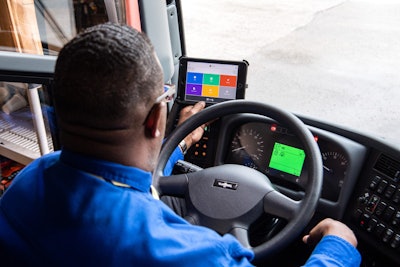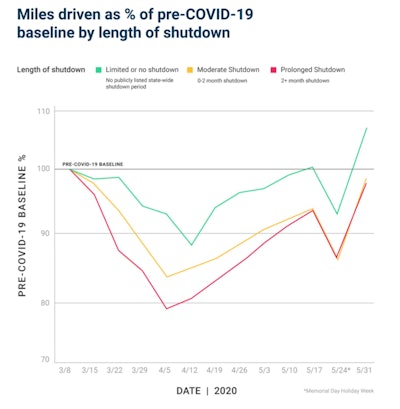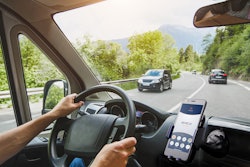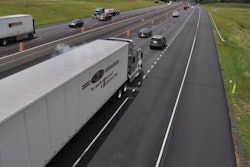
 Analysis by Samsara shows that vehicle miles returned to pre-COVID-19 levels after Memorial Day.
Analysis by Samsara shows that vehicle miles returned to pre-COVID-19 levels after Memorial Day.As states across the nation have lifted restrictions on stay-at-home orders, new analysis from ELD and fleet management technology supplier Samsara shows how varying restrictions impacted commercial transportation.
The analysis leveraged data from nearly 130 million trips and 15,000 fleet customers that operate across diverse industries that include transportation and logistics, food production and local government since the start of 2020.
Key findings show the following trends and changes in safety incidents before, during and after lockdowns across the United States:
- On average, states have returned to above 95% of pre-COVID-19 commercial driving activity in terms of miles driven and vehicles on the road.
- States that had limited or no shelter-in-place orders saw more modest declines during shutdown periods, and saw a 7% average increase in miles driven and vehicles on the road in the week after Memorial Day.
- States with prolonged shutdowns are starting to reach the same level of miles driven as states with only moderate shutdowns, despite having seen sharper declines in miles driven during peak periods of COVID-19. This may demonstrate all states are starting to return to pre-COVID-19 commercial driving activity, regardless of shutdown severity.
- Some industries — like passenger transit and education — have experienced a more significant impact while others, like long haul transportation, have recovered quickly.
- There has been a decline in certain unsafe driving behaviors like harsh braking and acceleration, but emptier roads have also resulted in a 20% increase in severe speeding (11+ mph over the posted speed limit).
Some states with limited shutdown guidelines, like Iowa and Nebraska, not only experienced very modest declines in baseline commercial driving activity (a 10% decline at worst), but more recently started to exceed pre-COVID-19 activity.
Other states with some regional restrictions still in place, like New Jersey, California, and New Mexico, are still experiencing a 5-10% reduction in commercial driving activity compared to pre-COVID-19 baseline levels.
Long haul transportation experienced a quick recovery from COVID-19. Food and beverage and wholesale trade transportation have also essentially reached pre-COVID-19 commercial driving activity. Other industries, like oil and gas, are operating at 60% of pre-COVID-19 commercial activity.
The construction industry is starting to clock in more miles, operating at 5% above pre-COVID-19 levels in recent weeks.
Changing driver behaviors
Data from fleet customers using Samsara’s AI dash cams show that COVID-19 has had an impact on the frequency of risky behaviors even when adjusted for decreased mileage.
 Analysis of commercial vehicle data by Samsara shows that severe speeding incidents increased by as much as 40% in April.
Analysis of commercial vehicle data by Samsara shows that severe speeding incidents increased by as much as 40% in April.Harsh braking and acceleration incidents decreased across all states, culminating at 40% below the pre-COVID-19 baseline per 1,000 miles driven. With fewer drivers out and about during shelter-in-place orders, roads presented more ideal conditions for safely decelerating.
While there was a decline in harsh braking and accelerations, data from Samsara customers using its Vehicle Gateways for live-to-the-second GPS fleet tracking and connectivity with the OBD port, show that severe speeding rose 20% in early April above the pre-COVID-19 baseline.
Large cities — especially those with strict shelter-in-place guidelines — had empty roads and experienced an even larger increase in severe speeding. A sample of five of the largest cities in the U.S. (Atlanta, NYC, Chicago, Houston, and San Francisco) reveals that speeding jumped 40% in early April compared to the 20% increase nationwide.
Speeding started to decrease in May as states began to lift shelter-in-place orders and more vehicles returned to the roads.













